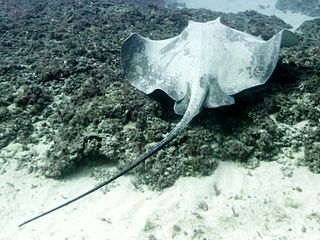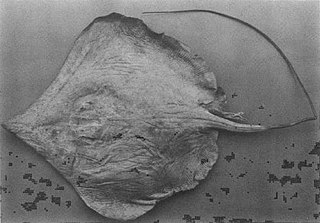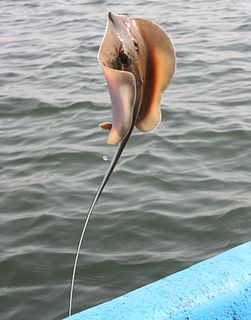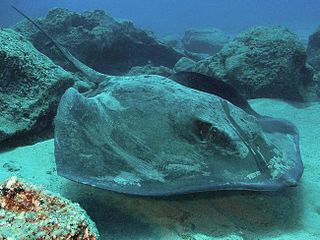 W
WDasyatis is a genus of stingray in the family Dasyatidae that is native to the Atlantic, including the Mediterranean. In a 2016 taxonomic revision, many of the species formerly assigned to Dasyatis were reassigned to other genera.
 W
WThe Atlantic stingray is a species of stingray in the family Dasyatidae, common along the Atlantic coast of North America from Chesapeake Bay to Mexico, including brackish and freshwater habitats. It may be distinguished from other stingrays in the area by its relatively elongated snout. This species is of little commercial importance, other than for sale in the aquarium industry.
 W
WThe blue stingray is a species of whiptail stingray of the family Dasyatidae often found in the coastal waters of southern Africa.
 W
WThe bluntnose stingray or Say's stingray is a species of stingray in the family Dasyatidae, native to the coastal waters of the western Atlantic Ocean from the U.S. state of Massachusetts to Venezuela. It is a bottom-dwelling species that prefers sandy or muddy habitats 1–10 m (3.3–32.8 ft) deep, and is migratory in the northern portion of its range. Typically growing to 78 cm (31 in) across, the bluntnose stingray is characterized by a rhomboid pectoral fin disc with broadly rounded outer corners and an obtuse-angled snout. It has a whip-like tail with both an upper keel and a lower fin fold, and a line of small tubercles along the middle of its back.
 W
WThe broad stingray, also known as the brown stingray or Hawaiian stingray, is a species of stingray in the family Dasyatidae. The predominant species of stingray in the inshore waters of the Hawaiian Islands, this benthic fish typically inhabits sandy or muddy flats at depths greater than 15 m (49 ft). Usually growing to 1 m (3 ft) across, the broad stingray has a wide, diamond-shaped pectoral fin disc with a protruding snout tip and a long tail with a ventral fin fold. At night, this species actively forages for bottom-dwelling invertebrates and bony fishes, often near the boundaries of reefs. Reproduction is aplacental viviparous. As substantial threats to its population do not seem to exist, the International Union for Conservation of Nature has listed this species as least concern.
 W
WThe common stingray is a species of stingray in the family Dasyatidae, found in the northeastern Atlantic Ocean and the Mediterranean and Black Seas. It typically inhabits sandy or muddy habitats in coastal waters shallower than 60 m (200 ft), often burying itself in sediment. Usually measuring 45 cm (18 in) across, the common stingray has a diamond-shaped pectoral fin disc slightly wider than long, and a whip-like tail with upper and lower fin folds. It can be identified by its plain coloration and mostly smooth skin, except for a row of tubercles along the midline of the back in the largest individuals.
 W
WThe daisy stingray, Dasyatis margarita, is a little-known species of stingray in the family Dasyatidae, found in shallow waters along the coast of West Africa. This species typically grows to 60 cm (24 in) across and has a rounded pectoral fin disc and a wide band of dermal denticles over its back. It is characterized by a greatly enlarged, nacreous denticle in the middle of its back called a "pearl spine"; this feature is shared with the similar but much smaller pearl stingray, which has often been confused with this species. The daisy stingray feeds mainly on crustaceans and exhibits aplacental viviparity, with litters of 1–4 young. Heavily pressured by fisheries and possibly habitat degradation, this once-common species is declining and has been assessed as Endangered by the International Union for Conservation of Nature (IUCN).
 W
WThe sharpnose stingray is a little-known species of stingray in the family Dasyatidae, found off southern Japan and in the East China Sea. With a rounded pectoral fin disc and a long, projecting snout, D. acutirostra resembles the smaller pale-edged stingray. A number of characteristics differentiate this species from D. zugei, including larger eyes and the absence of a dorsal fin fold on the tail. The International Union for Conservation of Nature (IUCN) has assessed this species as Near Threatened, as its restricted distribution renders it vulnerable to increases in fishing pressure.
 W
WThe diamond stingray is a species of stingray in the family Dasyatidae. It is found in the coastal waters of the eastern Pacific Ocean from southern California to northern Chile, and around the Galápagos and Hawaiian Islands. This bottom-dweller generally inhabits sandy or muddy flats near rocky reefs and kelp forests, to a depth of 30 m (98 ft), though off Hawaii it may range considerably deeper. As its common name suggests, this species has an angular, diamond-shaped pectoral fin disc that is plain brown or gray above, with rows of tubercles along the midline and on the "shoulders". The long, whip-like tail has both dorsal and ventral fin folds, which distinguish this ray from the closely similar longtail stingray (D. longa). It typically grows to 1 m (3.3 ft) across.
 W
WThe longnose stingray is a species of stingray in the family Dasyatidae, native to the western Atlantic Ocean from the southern Gulf of Mexico to Brazil. Found in coastal waters no deeper than 36 m (118 ft), this demersal species favors muddy or sandy habitats. The longnose stingray is characterized by its angular, rhomboid pectoral fin disc, moderately projecting snout, and whip-like tail with a dorsal keel and ventral fin fold. It typically grows to 1.25 m (4.1 ft) across and is brownish above and light-colored below.
 W
WThe longtail stingray, is a species of stingray in the family Dasyatidae, found in the eastern Pacific Ocean from Baja California to Colombia. It inhabits sandy habitats down to a depth of 90 m (300 ft). Measuring up to 1.56 m (5.1 ft) across, this species has a rhomboid pectoral fin disc, a lower fin fold on the tail, and numerous dermal denticles along the back and behind the stinging spine. The longtail stingray feeds mainly on bottom-dwelling bony fishes and crustaceans. It is aplacental viviparous, with females giving birth to 1–5 young in late summer. At present, the International Union for Conservation of Nature (IUCN) is unable to assess this species beyond Data Deficient. It is caught for food, likely throughout its range, but specific fishery data is lacking.
 W
WThe pale-edged stingray or sharpnose stingray is a species of stingray in the family Dasyatidae, found in the Indian and Pacific Oceans from India to the western Malay Archipelago and southern Japan. This bottom-dwelling ray is most commonly found over sandy areas shallower than 100 m (330 ft), as well as in estuaries. Measuring up to 29 cm (11 in) across, the pale-edged stingray has a diamond-shaped pectoral fin disc, a long projecting snout, small eyes, and a whip-like tail with both dorsal and ventral fin folds. It is chocolate brown above and white below.
 W
WThe pearl stingray is a little-known species of stingray in the family Dasyatidae, found in shallow coastal waters from Mauritania to Angola. Growing to 30 cm (12 in) across, this species has a rounded pectoral fin disc with a pointed snout, and a wide band of dermal denticles over the back in adults. It closely resembles and is often confused for the much larger daisy stingray ; both species are characterized by the presence of an enlarged, nacreous denticle in the middle of the back called a "pearl spine". The International Union for Conservation of Nature (IUCN) does not yet have enough information to assess the pearl stingray's conservation status, but it is likely that most of the historically reported fishery catches of the daisy stingray were in fact of this species.
 W
WThe pitted stingray is a species of stingray in the family Dasyatidae, endemic to the waters around Japan and the Sea of Japan. It typically found near the coast at depths of 40–60 m (130–200 ft), but may also venture into the open sea. Measuring up to 1.2 m (3.9 ft) across, the pitted stingray has a diamond-shaped pectoral fin disc with a characteristic "W"-shaped groove on the underside. Other identifying characteristics of this species include its dark gray dorsal coloration with small white spots, and the presence of dorsal tubercles in adults. Pitted stingrays are caught as bycatch in coastal fisheries and brought to market. The International Union for Conservation of Nature (IUCN) does not yet have sufficient data to assess this species beyond Data Deficient.
 W
WThe roughtail stingray is a species of stingray in the family Dasyatidae, with separate populations in coastal waters of the northwestern, eastern, and southwestern Atlantic Ocean. This bottom-dwelling species typically inhabits sandy or muddy areas with patches of invertebrate cover, at a depth of 15–50 m (49–164 ft). It is seasonally migratory, overwintering in offshore waters and moving into coastal habitats for summer. The largest whip-tail stingray in the Atlantic, the roughtail stingray grows up to 2.6 m (8.5 ft) across and 360 kg (800 lb) in weight. It is plain in color, with an angular, diamond-shaped pectoral fin disc and a long, whip-like tail bearing a subtle fin fold underneath. The many thorns on its back and tail serve to distinguish it from other stingrays that share its range.
 W
WThe sharpsnout stingray or wingfin stingray is a species of stingray in the family Dasyatidae, found from off Venezuela to northern Brazil. It inhabits shallow, brackish water, shifting towards the coast in the dry season and away from it in the rainy season. Typically measuring 70 cm (28 in) across, this dark brown ray is easily identifiable by its long, projecting snout and elongated, acutely pointed pelvic fins. Its diet consists of bottom-dwelling invertebrates. Reproduction is aplacental viviparous, with females bearing one to three pups annually. Naturally uncommon and slow-reproducing, the sharpnose stingray is under pressure by both artisanal and commercial fisheries, leading the International Union for Conservation of Nature (IUCN) to assess it as Near Threatened.
 W
WThe short-tail stingray or smooth stingray is a common species of stingray in the family Dasyatidae. It occurs off southern Africa, typically offshore at a depth of 180–480 m (590–1,570 ft), and off southern Australia and New Zealand, from the intertidal zone to a depth of 156 m (512 ft). It is mostly bottom-dwelling in nature and can be found across a range of habitats from estuaries to reefs, but also frequently will swim into open water. The largest stingray in the world, this heavy-bodied species can grow upwards of 2.1 m (6.9 ft) across and 350 kg (770 lb) in weight. Its plain-colored, diamond-shaped pectoral fin disc is characterized by a lack of dermal denticles even in adults, and white pores beside the head on either side. The body can have colors as well as dark grey or black with rows of white spots along each wing. Its tail is usually shorter than the disc and thick at the base. It is armed with large tubercles and a midline row of large thorns in front of the stinging spine which has the dorsal and ventral fin folds behind.
 W
WThe smalleye stingray is a large species of stingray in the family Dasyatidae, measuring up to 2.2 m (7.2 ft) across. Rare but widely distributed, it is found in the Indo-Pacific from Mozambique to India to northern Australia. This species may be semi-pelagic in nature, inhabiting both deeper waters and shallow coastal reefs and estuaries. It is characterized by a diamond-shaped pectoral fin disc much wider than long, a tail that is broad and flattened in front of the spine but whip-like behind, and large white spots over its back.
 W
WThe southern stingray is a whiptail stingray found in tropical and subtropical waters of the Western Atlantic Ocean from New Jersey to southern Brazil. It has a flat, diamond-shaped disc, with a mud brown, olive, and grey dorsal surface and white underbelly. The barb on its tail is serrated and covered in a venomous mucus, used for self-defense.
 W
WTethytrygon is an extinct genus of stingray in the family Dasyatidae.
 W
WThe thorntail stingray, black stingray, or longtail stingray is a species of stingray in the family Dasyatidae. It is found off southern Africa, Australia, and New Zealand from the intertidal zone to a depth of 440 m (1,440 ft). This bottom-dweller inhabits soft-bottomed habitats such as lagoons, estuaries, and reefs. Growing to 1.8 m (5.9 ft) across and over 200 kg (440 lb) in weight, the thorntail stingray is among the largest stingrays in the world. Uniformly dark above and light below, it has a diamond-shaped pectoral fin disc and a very long, whip-like tail with a fin fold underneath. The upper surface of the disc and the tail bear numerous stout, sharp thorns.
 W
WTortonese's stingray is a species of stingray in the family Dasyatidae, endemic to the Mediterranean Sea. It may be the same species as the common stingray.
 W
WDasyatis ushiei, the cow stingray or Ushi stingray, is a species of stingray known from a single specimen. Based on the single specimen, its range includes at least Mikawa Bay, Aichi Prefecture, middle Japan. Due to the limited knowledge of its biology and extent of capture in fisheries, this species is assessed as Data Deficient.